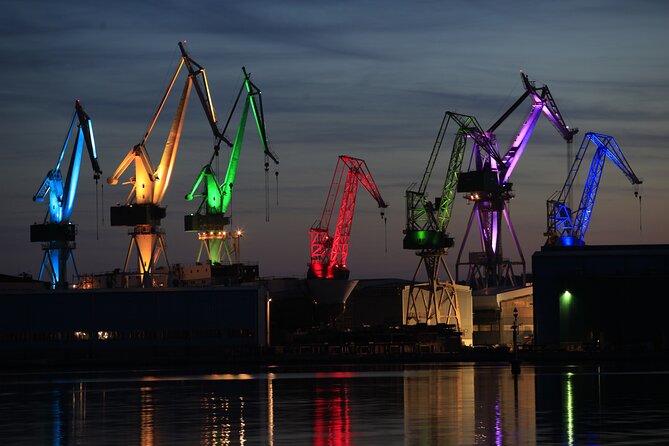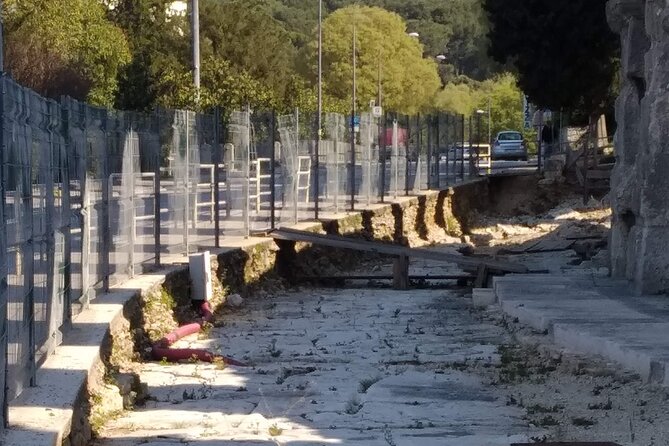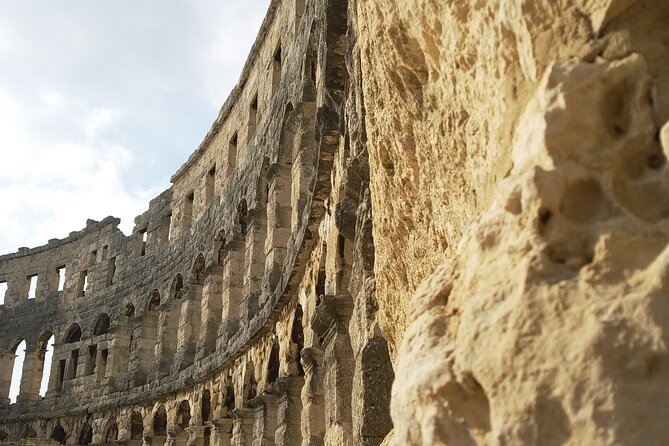Tucked away in the heart of Croatia, Pula’s ancient amphitheatre stands as a testament to Rome’s enduring legacy. This architectural marvel once hosted thrilling gladiatorial battles, where skilled warriors fought for their lives before captivated crowds. Imagine the clash of steel, the roar of the spectators, and the sheer adrenaline that pulsed through the arena. What secrets lie buried within these ancient walls? Uncover the fascinating stories of the gladiators who called this stage their own, and discover how their lives and legacies have echoed through the ages.
Key Points

- The Pula Arena, also known as the Arena of Pula, is one of the best-preserved Roman amphitheaters, constructed in the 1st century AD.
- Gladiatorial fights were central entertainment in ancient Rome, featuring various types of gladiators like Retiarii, Secutores, Murmillones, and Bestiarii.
- The Pula Arena is an architectural marvel, featuring an elliptical shape, three stories of arched entryways, and the ability to accommodate over 20,000 spectators.
- Gladiators faced a harsh reality characterized by intense training regimens, strict dietary requirements, and the constant threat of injury or death during matches.
- The Pula Arena exemplifies the grandeur of the Roman Empire’s influence in the region and remains a popular tourist attraction, offering insights into ancient Roman spectacles.
History of Pula’s Amphitheatre

The magnificent Pula Amphitheatre, also known as the Arena of Pula, is one of the best-preserved Roman amphitheaters in the world.
Built in the 1st century AD, this colossal structure was the central hub for entertainment and spectacles in the ancient Roman city.
Over the centuries, it’s weathered many storms, invasions, and natural disasters, yet it continues to stand tall, a testament to the ingenuity and engineering prowess of its Roman builders.
Today, visitors can wander through its grand arches and imagine the roar of the crowd and the clash of gladiators who once occupied this hallowed arena.
It’s a truly awe-inspiring site that transports you back in time.
You can also read our reviews of more tours and experiences in Pula.
Gladiatorial Fights and Spectacles
Amidst the grandeur of the Pula Amphitheatre, spectators were once captivated by the thrilling display of gladiatorial fights.
During the Roman era, these grand spectacles were a central entertainment event, drawing crowds eager to witness the clash of skilled warriors.
The fights featured:
- Retiarii – fighters equipped with a net and trident to entangle and dispatch their opponents.
- Secutores – heavily armored gladiators tasked with pursuing and eliminating the Retiarii.
- Murmillones – identifiable by their fish-crested helmets, they engaged in combat with swords and shields.
- Bestiarii – brave souls who battled fearsome beasts like lions and bears.
The roar of the crowd, the clash of steel, and the thrill of victory or defeat made these spectacles unforgettable in the annals of ancient Roman entertainment.
Architecture of the Pula Arena

Towering over the bustling streets of Pula, the ancient Roman arena captivates visitors with its remarkably well-preserved architecture.
The Pula Arena, also known as the Flavian Amphitheatre, is a true marvel of engineering. Its elliptical shape, measuring 132 by 105 feet, is a testament to the Romans’ mastery of construction.
With three stories of arched entryways and a capacity of over 20,000 spectators, this amphitheatre hosted thrilling gladiatorial contests and other public events in its heyday.
Today, the Pula Arena stands as a stunning reminder of the grandeur and spectacle that defined the Roman Empire, inviting visitors to step back in time and imagine the roar of the crowd.
Daily Life of Roman Gladiators
Beyond the grandeur of the Pula Arena, the lives of Roman gladiators were marked by a harsh reality.
These fearsome fighters faced daily physical and mental challenges, ranging from rigorous training to the ever-present threat of injury or death in the arena.
Their existence was defined by:
- Intense training regimens that pushed their bodies to the limit
- Strict dietary requirements to maintain their physical prowess
- A constant battle for survival, as they faced off against skilled opponents
- The looming uncertainty of their fate, which could be decided with a mere gesture of the emperor’s thumb
Yet, for some, the thrill of combat and the hope of earning fame and fortune outweighed the grim realities of their profession.
Significance of the Pula Arena

The Pula Arena stands as a striking testament to the grandeur and significance of the Roman Empire‘s influence in the region.
This remarkably well-preserved amphitheatre, dating back to the 1st century AD, offers visitors a glimpse into the captivating world of ancient Roman spectacles.
With its impressive dimensions and intricate architectural design, the Pula Arena served as a hub for thrilling gladiatorial contests, captivating the crowds with displays of valor and brutality.
Today, it remains a beloved tourist attraction, allowing modern-day explorers to enjoy the rich history and cultural traditions that once defined the Roman era in this enchanting Croatian city.
Guided Tour Experience Breakdown

Stepping into the grand arena of Pula, visitors embark on a captivating journey through time. The guided tour provides an immersive experience, bringing the amphitheatre’s rich history to life. Knowledgeable guides illuminate the arena’s fascinating past, transporting guests back to the glory days of ancient Rome.
The tour’s highlights include:
- Exploring the remarkably well-preserved structure and its unique architectural features.
- Learning about the dramatic gladiatorial battles that once enthralled audiences.
- Discovering the intricate system of underground tunnels and chambers.
- Gaining a deeper appreciation for the arena’s enduring cultural significance.
Whether you’re a history enthusiast or simply seeking an engaging adventure, this guided tour offers an unforgettable window into Pula’s ancient past.
Exploring Pula’s Ancient Attractions
Pulas Amphitheatre is just one of the ancient wonders that captivates visitors to this coastal Croatian city. Alongside the iconic Roman arena, Pula boasts a wealth of historical sites that transport you back in time. Stroll through the remnants of the Triumphal Arch of the Sergi, marvel at the Temple of Augustus, and uncover the secrets of the beautifully preserved Pula Forum.
| Attraction | Description | Hours |
|---|---|---|
| Pula Arena | Iconic Roman amphitheatre | Tues-Sat: 9am-10pm, Wed & Sun: 9am-12pm |
| Temple of Augustus | Remarkably well-preserved Roman temple | Tues-Sat: 9am-5pm |
| Pula Forum | Ancient Roman civic center | Tues-Sat: 9am-5pm |
| Triumphal Arch of the Sergi | Stunning Roman gateway | Tues-Sat: 9am-5pm |
Uncover the captivating history of this Croatian gem, where ancient Roman wonders stand tall, inviting you to explore the allure of the past.
Recap
Pula’s Amphitheatre is a remarkable testament to ancient Rome’s engineering prowess and the captivating world of gladiatorial combat. From the skilled Retiarii to the fearsome Secutores, the arena’s history is a thrilling blend of valor and brutality. Visitors can explore this architectural marvel, seeing the complex lives of the gladiators who once graced its hallowed grounds. It’s a captivating glimpse into the heart of Roman entertainment.
More Tour Reviews in Pula
Not for you? Here's more things to do in Pula we have recnetly reviewed
- 19 Best Canoe And Kayak Experiences In Pula
- 25 Best Canoe And Kayak Experiences In Pula
- 25 Best Cruises And Boat Tours In Pula
- 11 Best Dining Experiences In Pula
- 2 Best Jet-Ski Experiences In Pula
- 4 Best Food Tours In Pula
- 11 Best Dinner Tours In Pula
- 7 Best Lunch Experiences In Pula
- 2-Hour Guided Transparent Kayak Sunset Tour From Premantura
- Kayak and Snorkel Around Brijuni Islands
- Pula to Zagreb Private One Way Transfer
- Small-Group Pula Sunset Walking Tour With Local Dessert
